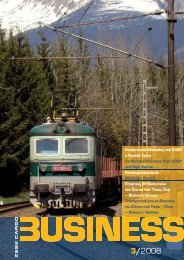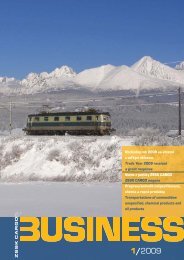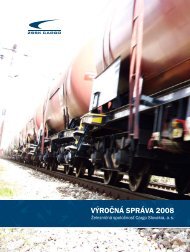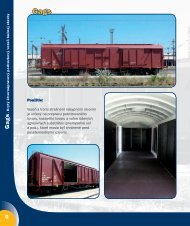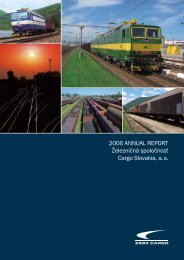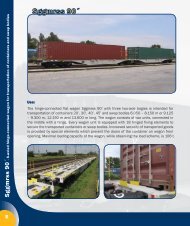CARGO BUSINESS 2-10.indd - ZSSK Cargo
CARGO BUSINESS 2-10.indd - ZSSK Cargo
CARGO BUSINESS 2-10.indd - ZSSK Cargo
- No tags were found...
Create successful ePaper yourself
Turn your PDF publications into a flip-book with our unique Google optimized e-Paper software.
oad infrastructure originated by lorries. Moreover, the implementationof tolling system faced a negative reaction from the road carriers.In case we avoid talking about technical problems or issue ofpreparedness and transparency of its implementation, we mayobserve, in particular, an increase in transport costs, and that in the“crisis” period, forcing the road carriers to reduce costs.Wave of protests by road carriers resulted in compromises fromthe government, in particular when it comes to reduction in exciseduty on diesel fuel. This should compensate for increased costs oftransportation in relation to toll. It is true that this compensation doesnot cover the increased costs of toll; however, it brought more than 11-percent reduction in diesel fuel prices. Therefore, from the viewpointof rail carriers, one question remains unanswered - why were suchcounter measures taken? These measures eliminate the originallyintended effects of the toll implementation, i.e. transfer of part ofgoods from road to rail due to increase of road transport costs. On thecontrary one can say that these measures actually reduce operationalexpenses of all road carriers regardless of the degree to which theyhave been using charged roads, and thereby favour the road carriersthat carry out transportations using the non-charged roads againstthe rail carriers.While rail carriers fully bear the costs of their own infrastructure,road carriers currently cover only a part of road infrastructure costs.The implementation of electronic tolling system is only a partialstep in harmonization of business conditions for individual modesof transport (as specified in Principles of State Transport Policy).Therefore, the outlook presented here is not very optimistic. Moresignificant changes could appear if Principles of State Transport Policyare implemented more consistently, particularly in the areas of:- harmonization of business conditions for all modes of transport(charges for use of infrastructure in full...),- internalisation of external costs (external costs caused by transportimpacts, which are not covered by their originators – elimination oftraffic accidents consequences, elimination of negative impactson the environment, air pollution, elimination of consequencesčnú harmonizáciu podmienokElectronic toll collection was introduced in Slovakia on 1. January2010 and its launch was accompanied by certain problems, as wellas offsets from the government (in particular, the reduction of exciseduty on diesel fuel and delay in implementation of the first class roadcharges) with a significant impact on the costs of road transport.Manifestation of the consequences related to toll implementationis a long-term matter. Therefore, it is still too early to fully assess itsimpacts. But the truth is that in the domestic transport of wood for theperiod January-August 2010, <strong>ZSSK</strong> <strong>CARGO</strong> registered an increase of142% compared to 2009, which was certainly affected by the crisis,but also a 20-percent increase compared to the “pre-crisis” year2008.It is technically not possible to accurately quantify the share of toll inthis growth, since it is obviously a sum of different effects, whether intrade policy of the rail carrier, toll itself, customers themselves andother. In other commodities there were no significant changes. Thiswas due to high (up to 60 percent) dependence of <strong>ZSSK</strong> <strong>CARGO</strong> ontransportations related to metallurgy, while this specific dependenceof road carriers is incomparably lower. The future may bringtransportations from road back to the railroad; however we assumethat this will happen in specific individual cases.Why did not the toll bring a more significant transfer of transportationsfrom road to rail? There are several reasons, but primarily it is a factthat the toll rates do not fully cover the proportional part of costs forof damage to health due to accidents, emissions, noise; part ofinfrastructure costs; impacts on area distribution and other).In principle, it can be assumed that if there is no real harmonizationof business conditions for all modes of transport, the road networkcapacity will be used to a limit extent, while the current spare capacityof rail network will remain unused.Rudolf KUBIŠMarketing Section14/15




